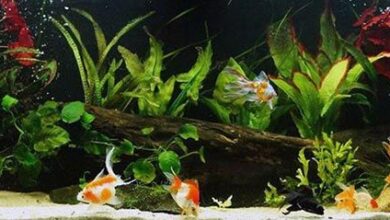Can Fish Drown? The Surprisingly Complicated Answer

Whether it’s from a new hobbyist or someone trying to win a trivia game, «Can Fish Drown?» It is one of the most common questions we get asked. This guide will help you understand if it is possible and help you understand the process.
Can fish drown?
Most people assume that fish are incapable of drowning. After all, they live and breathe underwater!
This may surprise many, but fish can easily die from lack of oxygen. Believe it or not, fish need oxygen to survive just like humans and air-breathing animals. When they don’t have access to usable oxygen, it’s impossible for them to stay alive.
You see, oxygen is responsible for supporting both terrestrial and aquatic life. Oxygen combines with other elements to create proteins and living cells. It also plays a role in storing energy that every biological function in a fish’s body uses to stay active.
Oxygen supports the organs and ensures that everything from the brain to the liver is working properly.

While it is dramatically different on the surface, there are several similarities between its body and the body of a fish. They both have a heart that continuously pumps oxygenated blood to various organs. Both also have organs that exchange oxygen for carbon dioxide.
The difference lies in how the fish breathe and how they get their oxygen.
Fish take advantage of dissolved oxygen in the water. You can’t see the oxygen molecules, but they’re there anyway.
The concentration of oxygen in water is between 2 and 8 PPM, or parts per million. By comparison, the air we breathe is about 210,000 PPM.
Fish clearly have a more challenging job to obtain oxygen. Fortunately, they don’t need as much as we do. Most fish are cold blooded. They can get by without using all the extra energy that warm-blooded animals use to stay alive.
Therefore, they can survive with much lower oxygen levels. Even so, fish still need oxygen to live.
So can fish drown?
In a sense, fish are quite capable of drowning in low-oxygen environments. But technically speaking, the correct term for what happens would not be «drowning.» What happens is closer to the act of suffocating me.
Author’s Note: Drowning is dying from inhaling water while submerged. Meanwhile, to suffocate is to die from lack of air or inability to breathe. When we look at the biological processes fish use to survive, suffocation is the more appropriate term.
When we refer to “drowning” fish in this article, we are simply using common terminology for the benefit of new owners. For those with a little more experience, know that we really mean suffocation.
The organs that fish use to breathe
The anatomy of a fish is complex and highly varied from one fish to another. That said, the respiratory system remains the same in most species. Understanding this is important if you want to understand how fish can drown.
But before we get into the organs that most fish use to breathe, let’s review some outliers.
There is a small group of six species of freshwater fish that have air-breathing lungs. They are appropriately called lungfish.
Lungfish used to be much more common. Several millennia ago, they became widespread and appeared in massive networks of freshwater lakes and rivers.
However, now only a small population remains. Thanks to their air-breathing nature, lungfish can adapt to the changing conditions of dry lake beds. They burrow into the substrate and enter a quasi-hibernation state to survive periods of drought.
While lungfish are quite rare, fish with a labyrinthine organ are easy to find. In fact, many species with this unique organ are popular in the aquarium trade!

The labyrinthine organs act as modified lungs. They allow fish to absorb atmospheric oxygen by swimming to the surface and taking a gulp (meaning drowning would have to be caused a little differently). The most popular labyrinth fish are betta fish and different types of gourami.
Most species of fish rely on a set of gills to breathe. The gills are a set of specialized organs on each side of the head. As the fish breathe, you can usually see them.
The gills look like red arches. The tiny filaments and flakes create an appearance that many compare to a car radiator. Most species have four gills on each side of the body. However, this number can vary a bit from species to species.
Regardless, the gills are responsible for complex gas exchange that help fish use dissolved oxygen to survive.
how they breathe
The breathing process of fish is complex and fascinating. The gills are very efficient organs that are capable of extracting even minute levels of dissolved oxygen from the water for use.
To access oxygen from their environment, fish must force water through their gills. To do that, most use a small flap of skin called an operculum. The operculum is that little slit that opens and closes when the fish breathes.
When they «take a breath,» fish adjust the pressure in their mouths to move the water. Lowering the floor of the mouth causes water to flow inward. By raising the floor, the water pushes out through the operculum.
As water passes over the gills, the feathery filaments extract dissolved oxygen through a process called countercurrent exchange. The epithelial tissue facilitates the absorption of oxygen into the bloodstream.
Because the oxygen levels in the water don’t come close to those in the air, fish need to move a lot of water to stay alive. The large surface area of the gills helps them collect as much oxygen as possible. If they can’t do this, they can drown (although we know it’s technically more like suffocation).
Reasons for Low Oxygen Levels in Water
Now that you understand how they breathe, let’s go over some of the reasons a fish can drown or suffocate. Even in a well-maintained tank, there is only a limited amount of oxygen to go around. Oxygen levels must be regularly replenished to keep the fish alive.
It is when oxygen levels drop too low that fish can drown. Anything below 2 PPM is considered a danger zone. These are some of the most common reasons why oxygen levels drop to dangerously low levels.
Overpopulation
There’s a reason aquarists always warn novices about overcrowding. It’s not just about the comfort and stress of the fish. Packing too many fish into a confined space is just asking for trouble.
As mentioned above, there is an oxygen limit for everyone. Fish need to use as much water as possible to collect the oxygen they need to survive. When there are too many fish in the habitat, the available oxygen levels are depleted quite quickly.
Before you know it, you will notice labored breathing and slow movements of the fish. Eventually the fish will begin to drop one by one due to drowning or suffocation.
Author’s Note: Avoid overcrowding at all costs. Read up on the space requirements for each fish and try to get the largest tank possible. If in doubt, take out some fish and store them in another tank. It is better to have less fish density than to create potential health problems.
algal blooms
Algal blooms can be a nightmare. They seem to happen out of the blue and can quickly turn your aquarium into a green mess.
Unfortunately, algae blooms are also detrimental to fish health. Bacterial populations proliferate rapidly. The algae consume all of the usable oxygen as they die and decompose, leaving very little for fish to use.
Even when the algae eventually die, oxygen levels take time to recover. The flowers drastically change the chemistry of the water. Some types of algae can even produce fatal toxins!
Author’s Note: Algal blooms usually occur due to excess nutrients. In many cases, it is a product of overfeeding.
high water temperatures
Many new owners asking, “Can fish drown?” they tend to forget about this possible cause. It is always important to be aware of water parameters such as temperature. Significant fluctuations not only cause stress in the fish, but can also alter oxygen levels.
Warmer water contains less dissolved oxygen than cold water. Higher surface temperatures make gas exchange between water and air less efficient, which will change the chemistry of the water.
poor water movement
In nature, water becomes oxygenated due to continuous movement. The breaking of the waves, the splashes and the flow under the water will infuse the water with oxygen. Surface movement is crucial!
This is how aquariums replenish the supply of dissolved oxygen. Your filter works to churn up the surface and keep things moving.
If the water is too stagnant, lower oxygen levels will surely follow.
The lower parts of the water column usually experience the deleterious effects first. The return flow from the filter helps churn the water and distribute oxygen evenly throughout the tank.
Once that stops, the surface may hold some oxygen. However, bottom feeding fish will suffer.
Author’s Note: Fortunately, fixing this problem is quite simple. You can clean your filter, add another pump, or use an inner tube. Anything that moves the water will help increase oxygen levels.
small water surface
This point is added to the previous one. As we said before, movement on the surface plays a big role in creating dissolved oxygen everywhere.
If your tank is small or lacks adequate surface area, oxygen levels can drop dramatically and cause your fish to drown.
This is why it is so dangerous to keep fish in small bowls or vases. Labyrinth fish, like the betta, can survive because they breathe atmospheric air. But standard fish will suffer from low oxygen levels from the start!
If you use a small bowl, make sure there is an air pump and bladder to oxygenate the water.
Too much plant and animal waste
Excess debris can have a terrible impact on your tank. The longer plant and animal waste remains in the water, the further the decomposition process will proceed.
While that may not seem like a big deal, decomposition requires dissolved oxygen. Much like an algae bloom, too much decomposition will deprive your fish of much-needed oxygen.
Keep the tank clean and use a gravel vac to remove debris from the tank. Regular water changes are also a good idea.
lighting and plant life
Plants are a fantastic way to infuse supplemental oxygen into a fish tank. However, they are only effective when you provide plants with a conducive growing environment.
One of the biggest mistakes newer aquarists make is ignoring lighting requirements. Aquatic plants need light to grow and photosynthesize. That way, they can use carbon dioxide and produce dissolved oxygen.
If you try to grow plants in a dark tank, the plant will become an oxygen hog. Go into survival mode and start consuming oxygen to survive.
Plants grown in dim lighting for extended periods can consume enough oxygen to adversely affect fish. Fortunately, the solution is simple. Just provide more lighting!
chemical treatments
Finally, oxygen levels can change due to chemicals in the water. Some substances will alter the water’s ability to carry dissolved oxygen (causing fish to drown or suffocate).
Be sure to read the warnings on all possible water additives.
If you plan on using chemical-based fish medications, consider increasing water circulation to be on the safe side. Use an air pump to overcome possible side effects of the water chemistry.
Ending
Now that you know the answer to the question, “can fish drown?”, it’s your job to make sure you provide a safe and healthy environment. Low oxygen levels can occur in a tank without much warning, so it’s important to keep an eye on things.
We hope this guide was informative and helped answer your question. If you need us to clarify something, just send a message.





